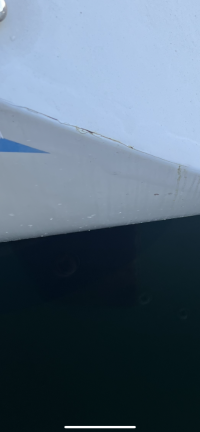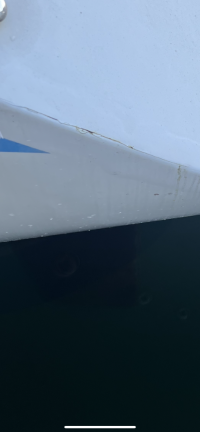When I first looked at your picture I thought, oh, that must be repair from a minor collision that was not done very skillfully, but is also not a big deal. When stopping by my boat today, a 1985 32-3, I decided to take a look at my own transom, and guess what. I seem to have a smaller cousin to that same crack in about the same place. That leads me to believe it's a standard issue of sorts with these boats, similar to the crack that many boats seem to have at the hull deck joint just behind the forestay mount. I've noticed that on some newer boats the aluminum rub rail runs all the way forward, perhaps because those cracks developed early and often and Ericson decided out of sight, out of mind. Anyway, looking at mine, it really appears to be a case of too sharp a corner and too much gelcoat in the mold, or some trouble with air bubbles sneaking in behind the layup. I'd for sure go snooping from inside, maybe just put a phone camera in video mode and reach deep inside there with the light on, and then see what it sees. In my case, there is maybe or maybe not evidence of a past contact with something, but it's not in a spot where that would be easy to do.
Anyway, having seen it on my own boat, I'm still not worried about it, and will add it to cosmetic repairs at next haul out. Nice thing about a non-cored hull, we don't need to panic every time we see flaw in the surface, worried that water is getting in there and spreading like a plague!
Also not really visible in my photo, but discussed earlier in this thread, though my hull is original gelcoat, the transom has been painted over at least once, and here are three dimensional ghosts of past boat names visible beneath the paint. Later boat names were done in vinyl letters which can be simply removed, which I appreciate. But there is evidence of paint lap lines near the perimeter, and they could easily be confused with substate repairs when they are not. I also don't believe this is a very high stress part of the boat, so it's not an obvious concern to me.
I liked the suggestion above us tapping with a plastic screwdriver to sound out damage, but if the gelcoat right next to the cack is lifting a bit, that's still not a big concern. several inches away, maybe.
In my case, I will inspect the interior, decide if it needs a little layup reinforcement, or is just a case of open up the gelcoat to a sound perimeter, clean off the glass beneath, and patch it up with white filler or gelcoat or both. Would not discourage me from buying the boat. Maybe knock of a grand for the repair and do it yourself, put the rest toward some upgrades elsewhere

picture of my own transom for context:







